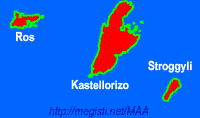Paradox Box
 |
| (Click to Enlarge) |
A few weeks ago, I started a series of reviews for some of the latest puzzles from renowned inventor Ivan Moscovich. Ivan's Hinge and Reflection were the first two, and as my third review I'll be writing about the Paradox Box, a blind maze with a twist...
The first thing you notice when you see the puzzle for the first time is its size - it's huge compared to a standard size Rubik's cube - with a diameter of 12.5cm (about 5"). It's a large puzzle, but it feels nice in your hands, as the edges are covered with this soft rubbery material that gives a nice grip for tilting and turning the cube.
The premise of the puzzle is simple: Just drop the small metal sphere into the cube and see if you can find your way out to the exit in the cube's opposite face, by navigating through an internal blind maze. Getting the sphere out, however, is everything but simple. There's a way to solve the maze and know how it works without the need to actually see what's going on inside, but for that you have to decode the Paradox Box's secret.
Each of the cube's faces is "decorated" with helpful clues, or hints, on how to follow the maze without falling into a trap, but there's no instructions on how to read these clues. It's up to you, though, to discover what they mean and how they can help you guide your sphere through the maze unscathed.
(Click to Enlarge) - Left: Entry; Right: Exit
To my knowledge, the secret of the Paradox Box is comprised by 3 types of clues: the first is found on the plastic cover of each of the cube's faces and consists of a series of arrows pointing in four different directions, apparently in random order; the second type of clue is marked on the actual faces of the cube and consists of several different colors scattered in a 5x5 grid. This pattern of colorful small squares create a strikingly beautiful visual effect, which makes the Paradox Box stand out in the crowd of your puzzle collection; finally, the last of the three clues is a little more subtle, and it's found at the corners of the colorful squares. They're nothing more than little "plus" and "minus" symbols, but they provide important information, sort of like "maze coordinates".
From the three types of clues, the last one is the one I believe to have deciphered its true meaning. The other two are a bit trickier to make sense of, but with patience and determination I'll get there. It's also possible that the other two clues, or maybe one of them, are mere decoys and don't mean anything, but I'd like to believe they hide some useful pattern to help me solve the puzzle much faster.
The first time I tried to solve the maze, I managed to get the sphere out just within a couple of minutes, and without paying too much attention to the clues. I suspected lady luck had something to do with it, and so I immediately dropped the sphere into the cube again... Suffice it to say, until now, the sphere is still inside the cube, so that proves something.
 |
| (Click to Enlarge) - One of the other four faces |
Once the sphere is inside the cube it's not easy to keep track of where exactly it is, so concentration is key. Even if you think you have deciphered all three types of clues you still have to rely on your touch and hearing as your guides. Practice makes perfect, and with the Paradox Box it's no different. Little by little you start to notice that the sphere makes different sounds as it goes through the maze, indicating that it reached higher or lower ground depending on the sound. Also, when you're holding the cube, it's possible to feel the sphere knocking the inside walls of the maze as a small thump, clearly revealing its location. These subtle sensory hints help you to locate the sphere and allow you resume where you left of if you haven't managed to solve the puzzle in one session.
Closing Comments:
The Paradox Box will delight any fan of 3D maze puzzles. The idea of having to discover the meaning of these clues, like deciphering a secret code, is a brilliant concept and it'll surely put your logic and spacial-visualization skills to the test. Highly recommended to anyone looking for a serious challenge.
Availability: You can get a copy of the Paradox Box at Fat Brain Toys for about $30 USD.

































0 comments:
Post a Comment